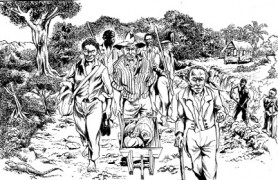A stranger to British Guiana, travelling from Crabwood Creek to Charity, would be forcibly struck by the number of times he would pass through substantial and well-defined village areas outside the sugar estates. He would be even more impressed to learn that in nearly a hundred of these villages corporate councils manage the local affairs of their hundred thousand inhabitants − transacting business to a value of three quarters of a million dollars in the course of an average year.

A hundred and twenty years ago, the countryside was almost bare of villages. Only four free coastal settlements were to be found that could possibly be described as villages. From East to West, the first of these was “The Winkel”, a small settlement on the outskirts of New Amsterdam that is now a part of that town. Next came a group of houses at the Mahaicony ferry, but so few in number that it is doubtful whether they should be dignified by the name of a village. The other two were somewhat larger. One was at the Mahaica ferry [and] the other at Aberdeen on the Essequibo Coast.
Against a background such as this, the forces that operated to produce the chain of villages that we know today had to be very powerful indeed. What were these forces? To find the answer we must turn to the general history of the period.
In an article on the administrative view of history in the May issue of the Magazine KyK-Over-al, I gave it as my personal view that history is essentially the record of the successive national decisions of a people, in its upwards striving on every front towards the attainment of the fuller life. The national decisions are enshrined in the laws of a country and reflect the policy of the Government on the various problems of the time. We need to know now, what was official policy on the question of village development, but to understand this we must look at the economic background.
The essential point in this background is that gold, diamonds, bauxite and rice – none of these was playing its present part and the Colony’s economy was wholly dependent on sugar production. But this was before the days of agricultural machinery as we know it. Without a supply of labourers to work in the canefields, the sugar industry was bound to collapse and, in doing so, it would submerge the economy of the entire country.
To avert this danger, emancipation had been introduced as a phased affair. Instead of fully liberating all the slaves in a single step, the workers had been made to serve a four-year period of apprenticeship, in which they were bound to continue to work for their former masters. With the end of apprenticeship in sight, the danger of a labour shortage re-appeared and something had to be done about it while a solution was being worked out through immigration.
One thing was certain. The free labourers would need to do work of one kind or another to secure food and clothing which they now had to provide for themselves. It was inevitable that they would look almost exclusively to agriculture, since this was the only career for which they were really fitted. But agriculture needs land, and it followed that so long as the freed apprentice could be kept without land of his own, just so long would he remain tied to the sugar plantation. In British Guiana, where unoccupied lands were available in large quantities, policy was carefully shaped towards producing a free but landless labourer.
To prevent squatting, the Apprenticeship Order-in-Council provided that an apprentice found five miles from his own plantation was subject to arrest. The unauthorized occupation of waste lands carried a penalty of three months imprisonment with hard labour, any apprentices found establishing themselves as distinct communities were to be dislodged and a vagrancy law was introduced, similar to that in force in England. As regards Crown lands, the policy adopted was to regulate the labour market by controlling the flow of such lands by means of price manipulations. For a start, Crown lands were to be alienated in minimum quantities of 100 acres, at a price of $4.80 per acre.
But in the minds of the labourers, powerful forces had begun to work. Prominent among them was the urge to do more than just eke out an existence by planting a provision farm to serve their own immediate needs. But the only economic crop they had any skill in handling was the sugarcane and their skill was based on plantation methods and not on peasant-farming. What is more, the old drainage system to which they were accustomed was one designed to serve an entire plantation. In short, cane-farming, as the labourers knew it, demanded a plantation and not a plot of the kind being sold by some of the planters, of which I shall tell you more in a moment.
But to the free labourer the urge to become a land-owner was more than an economic urge. It was also very largely psychological. In the past, the slaves had been part of a plantation. The sale of an estate as a going concern included the sale of its slaves. In this way, the ownership of land had come to connote mastery. To become a landowner meant that the freedman would have to call no man master. To own a plantation would be to achieve the ultimate in self-mastery.
In the case of Crown Lands, it was a simple matter for the Government to apply a restrictive policy. With privately-owned lands it was quite another matter. With these urges acting on the emancipated labourers, the planters found it impossible to adopt this policy, particularly in the case of the abandoned plantations, which remained responsible for maintaining their public road and sea defences and for which the owners were only too happy to find a market.
The number of these plantations was quite considerable by this time. Between the Corentyne and Mahaica rivers, for example, fully three-quarters of the plantations were out of cultivation and, on the entire Essequibo Coast, only two were still in operation. An abandoned plantation was beyond the means of the individual labourer but not beyond the combined resources of a group.
In the radio talks I gave two years ago, I described how, in November 1839, a group of 83 labourers from the five nearby Estates of Dochfour, Ann’s Grove, Hope, Paradise and Enmore on the East Coast of Demerara, combined to make the first collective purchase of a plantation for cane-farming. This was Northbrook, which has since become known as Victoria village. The price was $10,000, and more than $6,000 was subscribed in cash for the down-payment and, as I mentioned, in their eagerness the labourers were to be seen pushing this purchase-money in laden wheelbarrows through the streets of the city. The balance was covered by a pro-note which they were able to redeem in three weeks.
The migration from estate to village had begun. How were the planters to arrest it? The more far-seeing among them had already attempted a remedy. They had argued, with a good deal of merit that, if the freed apprentices owned or lived on plots of land on or near to an estate, they would be less likely to migrate and the planter would have near at hand a settled labour force. A number of villages were created in this way. Among them the name of Queenstown figures prominently.
The labourers in Demerara and Essequibo had started the movement. Those in Berbice were not slow to follow and, by 1840, four large collective villages were to be found on the West Coast of Berbice. On the Canje there were three flourishing villages and on the Corentyne Coast Fyrish had come into existence. These were followed within a year by Sisters on the Berbice River and Cumberland on the Canje and by villages at Springlands and Skeldon on the Corentyne Coast. Back in Demerara, villages were springing up on both banks of the Demerara River, on the West Coast and in Canal No. 1.
And so with these urges and from these origins the village movement came into being. The inflation in land values that followed the opening of the movement had little effect in arresting its progress. On the other hand, a general strike in 1842 did much to accelerate it. Before the end of that year, 16,000 labourers, alarmed at the threat of eviction by the planters, had migrated from estate to village. By the end of 1844 the villagers numbered 19,000. By the middle of 1847, they totalled 30,000.
In the book called The Approaches to Local Self Government in British Guiana that has just been published I have traced in some detail, the rise and fall of the village movement. Here, I must sum up by saying that in less than ten years the village movement was on the decline.
As with the beginning of the movement, the first cause was economic but, as before, the psychological factor played an important part for it was this psychological factor more than anything else that cut off the village movement at the height of its glory. The economic forces were free trade and the 1847 economic crisis in Britain. At the height of this crisis in British Guiana, the bank failed for a while. The labourers refused to accept banknotes in payment of wages. Paper money was hawked through the streets and bought by the Portuguese shop-keepers at 20 per cent below par.
This was a situation that brought home to the labourers, for the very first time, the economic hazards inherent in their new-found freedom. The fact that a banknote could lose its purchasing power struck at the very foundations on which their new life of industry and thrift was being built. What did it profit a man to labour so industriously for a roll of bank-notes when, in the twinkling of an eye, the banknote might lose its purchasing power?
The village movement was basically the investment of savings in the purchase of land but what if, in this process, the savings could lose some of their value? The realization that this was possible undermined the incentive for the village movement. But by this time the value of village property had reached a total of two and a half million dollars at a conservative estimate. As regards people, the villages and settlements held between them more than 40,000 creoles; the estates held less than half that number.
But the village movement was far from its end. Twenty years later it had a revival in the East Indian settlements movement started with the object of inducing the immigrant to remain in the Colony at the end of his period of indenture under an arrangement by which he would commute his right to return passage in favour of a small land-holding.
After the first unsuccessful attempts at Nooten Zuil and Huis t’Dieren, this phase of the movement reached its peak in such villages as Bloomfield, Whim and Bush Lot, Maria’s Pleasure, Helena and Clonbrook. In our own time, we are witnessing the third phase of the village movement. I am referring to our land settlement schemes and to the extra-nuclear housing areas that have been springing up so rapidly on the sugar estates within the last few years.
With a magic stroke of the pen, Her Majesty the Queen had transformed the legal, civic and social status of 80,000 serfs in British Guiana. In what I have already described as the greatest un-aided self-help scheme ever to be witnessed in this country, the new citizens had triumphed over a restrictive land policy to transform their own economic status.
If for no other reason than this, the village movement will always demand a place of its own in the historical literature of Guiana.









